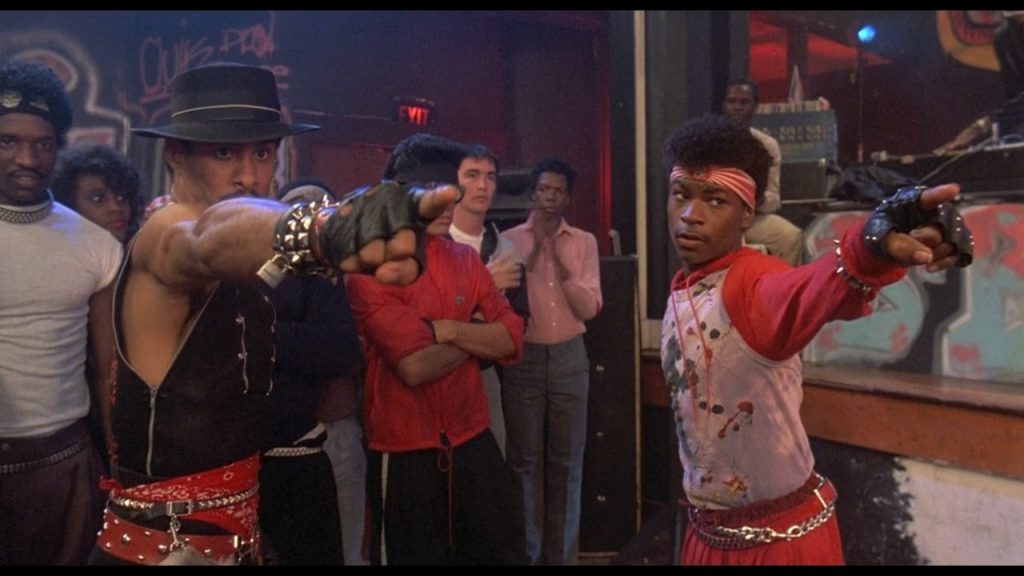Breakin’ (1984)

Wholly dated by today’s standards, but then, all the more reason to watch. Breakin’ (originally titled in production as Breakdance (which it was still called in foreign markets), then Break Dancin’) is an earnest attempt at a feel-good break-dancing drama. It ends up being unintentionally funny most of the time, yet, at the same time, it’s so hard to dislike. Of course, coming out in the mid-80s at the peak of the showcased dance craze, it enjoyed a bit more seriousness at the time of release. However, there’s no better non-documentary film that is specifically about the “fad,” so even if it isn’t the best dance film you’ve ever seen, did anyone really expect a great movie here?
Former “Solid Gold” dancer Lucinda Dickey stars as Kelly, a waitress by day, aspiring jazz dancer in her spare time. She has the looks and talent to go far, at least according to her dance instructor, but this move seems to come at a price, as he wants a little action on the side to help her career. She makes friends with a couple of local street dancers, aka break-dancers, Ozone and Turbo, and she becomes enamored of the mannerisms and moves of the street dancers. They agree to teach her some steps in order to gain street rep, while she has a crazy idea to make break-dancing more mainstream in the form of a staged musical about it. Alas, the conservative art crowd scoffs at the idea, as do the rival street-dancing crews who want to be prove they are the best of the bunch.
The silliness factor is at an all-time high when you have street-tough Ozone and Turbo showing their softer side, and even rivalries with other “dance gangs” end up being some very silly “pop and lock” duels in place of any physical violence. There’s a prominent poster for West Side Story displayed every once in a while, and it’s obvious a great deal of that play/film’s inspiration drifted in, especially during the choreographed dance-rumble numbers. That’s not the only influence, as Flashdance-type montages permeate much of the musical numbers, as well as a good deal of the plot points.
Breakin’ is directed by veteran Israeli filmmaker Joel Silberg, a longtime collaborator on Golan and Globus films, and marks his first film directed in America. Silberg isn’t so much interested in making an accurate portrayal of the break-dancing scene so much as trying to entertain audiences mostly unfamiliar with the style or the culture that had been viewed as a roaring fad in the early 1980s. While the dancing is certainly amazing, it is clear that the film itself is merely an attempt to cash in on a craze more so than to tell a compelling story about overcoming the odds to success. Filming mostly took place in Southern California, with a few exterior scenes on various Los Angeles locations like Venice Beach (where we glimpse a young Jean-Claude Van Damme as an enthusiastic extra), the Palace in Hollywood, and the Shrine Auditorium.
The actors were not very seasoned, and rumors are that Lucinda Dickey in particular was not accepted with open arms by Quinones in particular for her jazz dance style and his feeling that she was trying to show he and Michael Chambers up with her gymnastic techniques rather than try to do the dance moves as they instructed. Dickey, in response, felt the exact opposite was taking place, and it was her co-stars who were always trying to show her up by making her perform moves that were too difficult for her to do well, and would try to make her look bad, causing her to lean on her already learned strengths.
For the most part, Breakin’ is still worth a watch for the nostalgia value, or, at the very least, for an unintentionally campy romp. The stars are mostly cast for their dance abilities, and, when they are dancing, it’s about the only time they seem to be comfortable in the film. They aren’t the best in the acting department, but do a decent enough job as amateurs not to be wholly unbelievable. Like many films around this time of music videos, much of the movie is spent trying to hock the killer soundtrack, which was probably even more popular than the movie here, even though these aren’t what you would call typical break-dancing beats. No real live performances save Ice-T, who gives you a taste of some of his earliest work, again, strictly for those who are curious.
Breakin’ would end up becoming a “break out” hit for Cannon Films, debuting at #1 at the box office in its first week of release, racking up over $38 million dollars on a reported budget of only $2 million, and placing it among the top twenty highest grossing films in the U.S. in 1984 (yes, it was a bigger box office hit than The Terminator, Sixteen Candles (which debuted the same weekend), The Neverending Story, and A Nightmare on Elm Street). It would prove to be Cannon’s biggest box office hit in their history, raking in over 50% more than their next biggest hit, the Chuck Norris war pic, Missing in Action. They knew they had a hit on their hands, and the film would prove so popular that the sequel was immediately put into production before it ever hit theaters, originally titled Electric Boogaloo as announced during the recap music video montage prior to the end credits. Breakin’ 2: Electric Boogaloo, as it would be famously titled, was released a mere seven months later.
Qwipster’s rating: C
MPAA Rated: PG for some language
Running Time: 90 min.
Cast: Lucinda Dickey, Adolfo “Shabba-Doo” Quinones, Michael “Boogaloo Shrimp” Chambers, Christopher McDonald, Ben Lokey, Phineas Newborn III
Director: Joel Silberg
Screenplay: Charles Parker, Allen DeBevoise, Gerald Scaife
